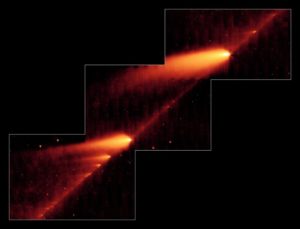

Strange Sounds – May 23, 2022
Heads up! On May 30-31, 2022, we might have a brief-but-intense meteor display, thanks to a comet that split apart in 1995 and is apparently still fragmenting. It might happen, as Earth passes through a particularly dense stream of icy particles which the comet left behind in the years 1995, 1897 and 1892.
Intense meteor display possible from comet SW3
If it does happen, we’ll see a grand display of meteors! And, even if it doesn’t, this comet is one you’ll want to come to know.
The meteor shower is the Tau Herculids. Its parent comet is 73P/Schwassmann-Wachmann 3, aka SW3. Astronomers found this comet in 1930. It orbits the sun every 5.4 years. And the comet will be in our evening sky again, in July and August 2022. It’s not an intrinsically bright comet. But it’s an exceptionally interesting comet. In 1995, astronomers watched as this comet began to fracture and litter its orbit with an increasing amount of debris.
That’s why, by some recent calculations, the May 2022 Tau Herculid meteor shower – spawned by SW3 – might be an intense display. Bill Cooke, who leads NASA’s Meteoroid Environment Office, said:
“This is going to be an all or nothing event. If the debris from SW3 was traveling more than 220 miles per hour (354 kph) when it separated from the comet, we might see a nice meteor shower. If the debris had slower ejection speeds, then nothing will make it to Earth and there will be no meteors from this comet.”

